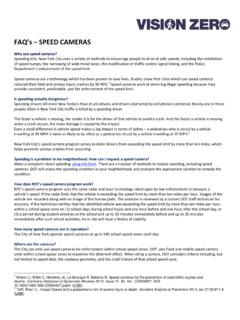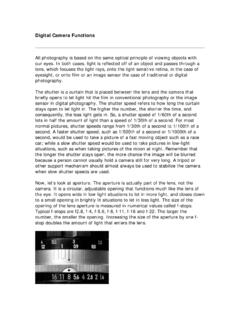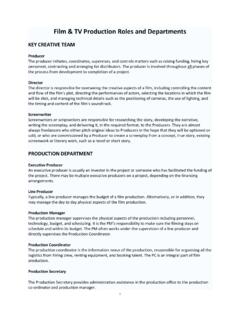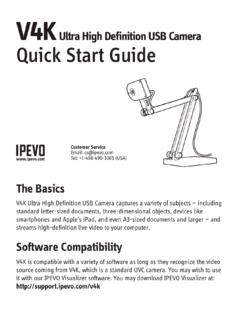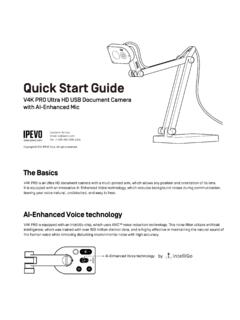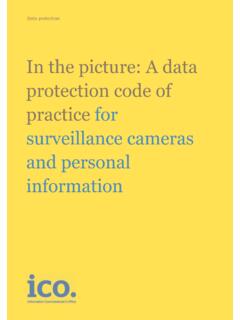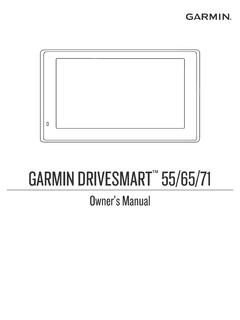Transcription of Safety and Security Camera Acceptable Use Policy
1 A Virginia Polytechnic Institute and State University Safety and Security Camera Acceptable Use Policy Purpose N O . 5617 Virginia Tech is committed to enhancing the quality of life of the campus community by integrating the best practices of Safety and Security with technology. A critical component Policy Effective Date: of a comprehensive Security plan is the utilization of a Security and Safety Camera system. 3/1/2010. The surveillance of public areas is intended to deter crime and assist in protecting the Safety and property of the Virginia Tech community. This Policy addresses the university's Safety Last Revision Date: and Security needs while respecting and preserving individual privacy. 3/14/2017. Policy Owner: To ensure the protection of individual privacy rights in accordance with the university's core Sherwood Wilson values and state and federal laws, this Policy is adopted to formalize procedures for the installation of surveillance equipment and the handling, viewing, retention, dissemination, Policy Author: and destruction of surveillance records.
2 The purpose of this Policy is to regulate the use of (Contact Person) Camera systems used to observe and record public areas for the purposes of Safety and Kayla Smith Security . The existence of this Policy does not imply or guarantee that cameras will be monitored in real time 24 hours a day, seven days a week. Affected Parties: Undergraduate Graduate Policy Faculty The Virginia Tech Police Department (VTPD) has the authority to select, coordinate, Purpose operate, manage, and monitor all campus Security surveillance systems pursuant to this Policy Policy . All departments using Camera surveillance are responsible for implementing and Procedures complying with this Policy in their respective operations. Definitions References All existing uses of Security Camera systems will be required to comply with the Policy at a Approval and future date.
3 A notification of the compliance date will be made 12 months in advance. Revisions Unapproved or nonconforming devices will be removed prior to the compliance date. A university Surveillance Oversight Committee (SOC) is an operational committee established by the Vice President for Administration to oversee implementation of this Policy . Proposed Policy revisions will be reviewed by the SOC and the University Safety and Security Policy Committee. Responsibilities VTPD, in conjunction with Information Technology and the Office of Emergency Management (OEM), is responsible for realization and assimilation of the Policy . Information Technology and the VTPD are responsible for advising departments on appropriate applications of surveillance technologies and for providing technical assistance to departments preparing proposals for the purchase and installation of Security Camera systems.
4 S A F E T Y A N D SE C UR IT Y C A ME RA A C CE P TA B LE USE P OL I CY | N O . 5 6 1 7 | 1. a Virginia Polytechnic Institute and State University VTPD and Information Technology shall monitor developments in the law and in Security industry practices and technology to ensure that Camera surveillance is consistent with the best practices and complies with all federal and state laws. VTPD and Information Technology will review proposals and recommendations for Camera installations and review specific Camera locations to determine that the perimeter of view of fixed location cameras conforms to this Policy . Proposals for the installation of surveillance cameras shall be reviewed by the Chief of Police or designee. Recommendations shall be forwarded to the SOC.
5 VTPD and OEM will assess new Camera locations and will conduct an evaluation of existing Camera locations and incidents as necessary. Maintenance and testing will be the responsibility of the department utilizing the Camera system. VTPD will review any complaints regarding the utilization of surveillance Camera systems and determine whether this Policy is being followed. Appeals of a decision made by the Chief of Police will be made to and reviewed by the SOC which will make a recommendation to the Vice President for Administration, who will render a decision. An appeal of the Vice President for Administration's decision may be taken to the university President who is the final arbiter. Responsibilities of Surveillance Oversight Committee (SOC).
6 The SOC will be responsible for reviewing and approving or denying all proposals for Security Camera equipment recommended by the Chief of Police. The SOC shall be responsible for the review and approval of any requested exceptions to this Policy . The SOC shall propose to the Vice President for Administration appropriate changes to this Policy as needed. The SOC shall be comprised of five members: The Chief of Police or designee, Chair of the SOC. Chief Information Officer or designee Vice President for Student Affairs or designee Associate Vice President and Chief Facilities Officer or designee Assistant Vice President for Emergency Management or designee Responsibilities for Review of External Requests for Records Release The VTPD will review all external requests to release records obtained through Security Camera surveillance.
7 The VTPD will seek consultation and advice from University Legal Counsel and other departments as deemed appropriate related to these requests prior to the release of any records. Scope This Policy applies to all personnel, departments, and colleges of Virginia Tech in the use of Security cameras and their video monitoring and recording systems. Security cameras may be installed in situations and places where the Security and Safety of either property or persons would be enhanced. Cameras will be limited to uses that do not violate the reasonable expectation of privacy as defined by law. Where appropriate, the cameras may be placed S A F E T Y A N D SE C UR IT Y C A ME RA A C CE P TA B LE USE P OL I CY | N O . 5 6 1 7 | 2.
8 A Virginia Polytechnic Institute and State University campus-wide, inside and outside buildings. Although the physical cameras may be identical, the functions of these cameras fall into three main categories: A. Property Protection: Where the main intent is to capture video and store it on a remote device so that if property is reported stolen or damaged, the video may show the perpetrator. Examples: an unstaffed computer lab, an unstaffed science lab, or a parking lot. B. Personal Safety : Where the main intent is to capture video and store it on a remote device so that if a person is assaulted, the video may show the perpetrator. Examples: a public walkway, or a parking lot. C. Extended Responsibility: Where the main intent is to have the live video stream in one area monitored by a staff member in close proximity.
9 In this case video may or may not be recorded. Example: a computer lab with multiple rooms and only one staff. General Principles Information obtained from the cameras shall be used for Safety and Security purposes and for law and Policy enforcement, including, where appropriate, student judicial functions. Information must be handled with an appropriate level of Security to protect against unauthorized access, alteration, or disclosure in accordance with Policy 7105, Policy for Protecting University Information in Digital Form ( ). All appropriate measures must be taken to protect an individual's right to privacy and hold university information securely through its creation, storage, transmission, use, and deletion. All Camera installations are subject to federal and state laws.
10 Departments requesting Security cameras will be required to follow the procedures outlined in this Policy . Placement of Cameras The locations where cameras are installed may be restricted access sites such as a departmental computer lab;. however, these locations are not places where a person has a reasonable expectation of privacy. Cameras will be located so that personal privacy is maximized. No audio shall be recorded except in areas where no one is routinely permitted. Requests to utilize audio surveillance that does not comply with this requirement will be evaluated on a case by case basis by the SOC. Camera positions and views of residential housing shall be limited. The view of a residential housing facility must not violate the standard of a reasonable expectation of privacy.




